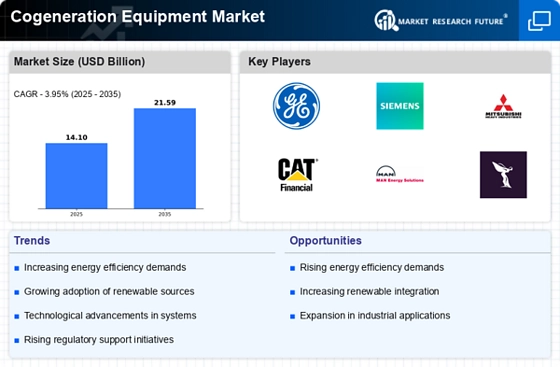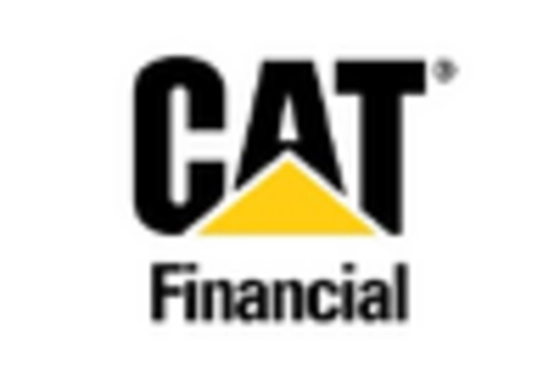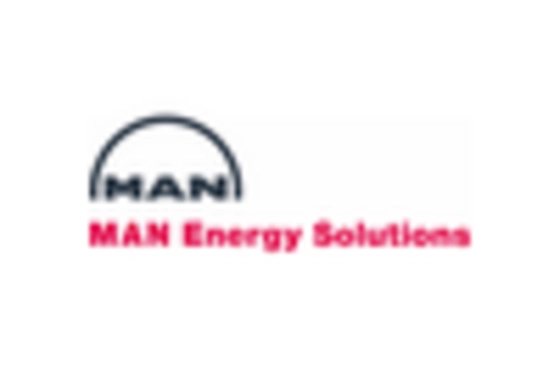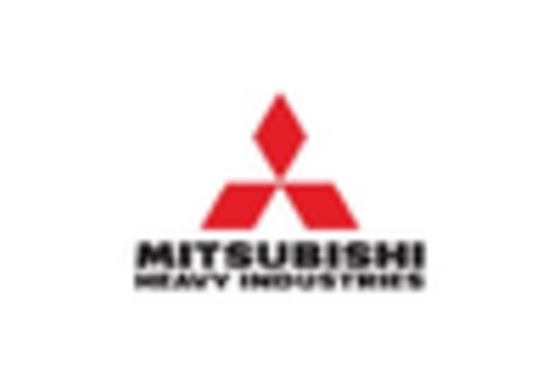Increasing Energy Costs
The rising costs of energy are compelling industries to seek more efficient solutions, thereby driving the Cogeneration Equipment Market. As traditional energy sources become more expensive, businesses are increasingly turning to cogeneration systems to reduce their energy bills. These systems allow for the simultaneous production of electricity and useful heat, which can lead to substantial savings. According to recent data, cogeneration can achieve efficiencies of up to 90%, compared to conventional systems that typically operate at around 30 to 40% efficiency. This stark contrast highlights the financial benefits of adopting cogeneration technologies, making them an attractive option for various sectors, including manufacturing and commercial buildings. Consequently, the demand for cogeneration equipment is expected to rise as organizations look to mitigate energy costs and enhance their operational efficiency.
Technological Innovations
Technological advancements are playing a pivotal role in shaping the Cogeneration Equipment Market. Innovations in engine design, control systems, and fuel flexibility are enhancing the performance and efficiency of cogeneration systems. For instance, the integration of smart grid technologies allows for better energy management and optimization of cogeneration operations. Furthermore, advancements in renewable energy integration, such as biogas and biomass utilization, are expanding the applicability of cogeneration systems. The market for cogeneration equipment is projected to grow as these technologies become more accessible and cost-effective. According to industry forecasts, the cogeneration market is expected to witness a compound annual growth rate of over 5% in the coming years, driven by these technological improvements. This growth reflects the increasing recognition of cogeneration as a viable solution for energy generation.
Supportive Government Policies
Supportive government policies are significantly bolstering the Cogeneration Equipment Market. Many countries are implementing incentives, subsidies, and tax breaks to encourage the adoption of cogeneration technologies. These policies aim to promote energy efficiency and reduce environmental impacts, making cogeneration systems more financially attractive for businesses. For example, feed-in tariffs and renewable energy credits are often provided to facilities that invest in cogeneration solutions. Such initiatives not only lower the initial investment barriers but also enhance the return on investment for companies adopting these technologies. As a result, the market for cogeneration equipment is likely to expand as more organizations take advantage of these favorable regulatory frameworks. The alignment of economic incentives with energy policy objectives is expected to drive further growth in the cogeneration sector.
Environmental Sustainability Initiatives
The increasing emphasis on environmental sustainability is significantly influencing the Cogeneration Equipment Market. Governments and organizations are actively pursuing strategies to reduce greenhouse gas emissions and promote cleaner energy sources. Cogeneration systems, which utilize waste heat for additional energy production, align well with these sustainability goals. By improving energy efficiency and reducing reliance on fossil fuels, cogeneration technologies contribute to lower carbon footprints. Recent studies indicate that cogeneration can reduce CO2 emissions by up to 30% compared to conventional energy generation methods. As more entities commit to sustainability targets, the adoption of cogeneration equipment is likely to accelerate, driven by both regulatory pressures and corporate responsibility initiatives. This trend not only supports environmental objectives but also enhances the market potential for cogeneration solutions.
Rising Industrialization and Urbanization
The ongoing trends of industrialization and urbanization are contributing to the growth of the Cogeneration Equipment Market. As urban areas expand and industries proliferate, the demand for reliable and efficient energy sources is increasing. Cogeneration systems offer a practical solution to meet the energy needs of densely populated regions and industrial facilities. The ability to generate electricity and heat on-site reduces transmission losses and enhances energy security. Recent estimates suggest that urban areas account for over 70% of global energy consumption, underscoring the critical need for efficient energy solutions. Consequently, the adoption of cogeneration technologies is likely to rise as cities and industries seek to optimize their energy use and reduce operational costs. This trend presents a substantial opportunity for the cogeneration equipment market to flourish in response to growing energy demands.


















Leave a Comment